|
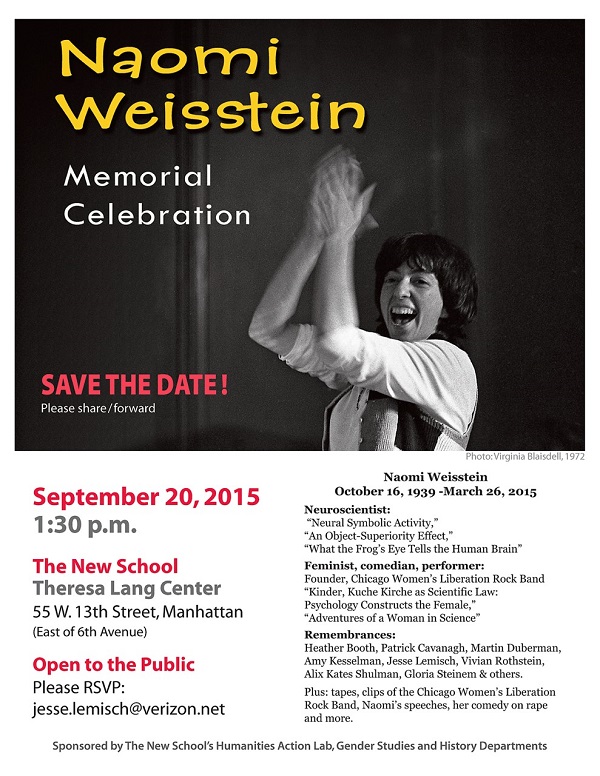
Sadly, VFA learned of the passing of a VFA member and feminist icon, Naomi Weisstein...Her husband, Jesse Lemisch, who has cared for her for many years, was at her side.
Naomi, one of the most brilliant and exciting of the young radical feminists, was also the founder of the first all women's band. She was a pioneering neuroscientist, among the initiators of the Cognitive Revolution.
FROM JESSE LEMISCH
Naomi fell ill with Myalgic Encephalomyelitis/Chronic Fatigue Syndrome in 1980 and became completely bedridden in 1983. We fought America’s most powerful insurance companies in court and in the press (see Lemisch, “Do They Want my Wife to Die?” New York Times, April 15, 1992 http://www.nytimes.com/1992/04/15/opinion/do-they-want-my-wife-to-die.html) and defended her 24/7 home nursing, which continued until the day of her death.
Among her most heroic works are her creative articles in science and feminism, written in this period, entirely from her bed. In March 2015 she was diagnosed with ovarian cancer at New York City’s Lenox Hill Hospital. In every way possible, LH expressed ignorance and contempt for her underlying ME/CFS. (See Gina Kolata’s “Doctors Strive to do Less Harm, New York Times, February 18, 2015 http://www.nytimes.com/2015/02/18/health/doctors-strive-to-do-less-harm-by-inattentive-care.html?_r=0, which, without naming LH, fit precisely the harms committed by the institution; not a soul who I encountered at LH took cognizance of this front-page article, published during Naomi’s hospitalization.)
Whatever strength Naomi had assembled during her 30+ years of careful nursing fell victim to Lenox Hill’s abuse and utter inattention to this underlying condition. Discharged in grim condition on March 17, in agony, she required hospitalization only two days later. We chose Mount Sinai Hospital, a far more humane institution. But it was too late: she died at 11 PM Thursday March 26. As death approached, I sang to her: “September Song,” “Swing Low, Sweet Chariot,” and, as she had always sung to me in troubled times, “Hush, Little Baby, Don’t You Cry.”
Our hearts go out to Jesse and all her beloved friends and family. She will be missed, but she gave so much to the world, that she'll never be forgotten, Rest in peace, dear Naomi. Jacqui Ceballos for VFA
NAOMI WEISSTEIN - A LIVING LEGEND. Feminist of the Month November 2010
AUTHOR, KINDER, KUCHE, KIRCHE AS SCIENTIFIC LAW: PSYCHOLOGY CONSTRUCTS THE FEMALE"; COFOUNDER, AMERICAN WOMEN IN PSYCHOLOGY AND CHICAGO WOMEN S LIBERATION; ORGANIZER, WOMEN S LIBERATION ROCK BAND
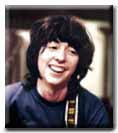 One of the most brilliant and fascinating of the early radical feminists is Naomi Weisstein, probably best known for her pioneering 1967 essay, Kinder, Kuche, Kirche ( Children, Kitchen, Church ), which started the discipline of the psychology of women, and has been reprinted over 42 times in six different languages. One of the most brilliant and fascinating of the early radical feminists is Naomi Weisstein, probably best known for her pioneering 1967 essay, Kinder, Kuche, Kirche ( Children, Kitchen, Church ), which started the discipline of the psychology of women, and has been reprinted over 42 times in six different languages.
Besides her scholarly talents and achievements Naomi is an actor with a great sense of humor. She was one of the early feminist stand-up comedians, and in the 1970 s took part in Eve Merriam s Off Broadway One Woman Show. Also musically gifted, she organized the Chicago Woman s Liberation Rock Band in 1970 "to shake up the sexist world of pop music." (Her story of that experience is included below). She has been ill for many years with Chronic Fatigue Syndrome and is bedridden, so was unable to write her bio. However there is much about her on the web, which we have excerpted here. But in no way can it describe the impact she s had on the new feminist movement.
Naomi was born in New York City in 1939 to Mary Menk and Samuel Weisstein. She graduated Phi Beta Kappa from Wellesley College in 1961 and by 1963 was a socialist, a civil-rights activist and a member of the New Haven Congress of Racial Equality. From there she went to Harvard to earn her Ph.D.
Naomi says she encountered sexism at every turn, as a student and when she applied for teaching positions. While at Harvard her feminist militancy was sharpened by experiences in male-dominated science and by the treatment of women students. One day she was denied entrance to the library because, she was told, women distracted serious scholarship. That evening she and friends, dressed in skin-tight leotards, met in front of the library and with clarinet, two tambourines and an old trumpet serenaded the scholars and shouted, You want distraction, we'll show you distraction! The library changed its policy immediately.
Sexism in her own department made it necessary to spend a year at Yale to complete her doctoral research because the psychology department at Harvard would not let her use the tachistscope, which was essential for her research. During this time she met and later married the radical historian, Jesse Lemisch, currently professor emeritus at John Jay College of Criminal Justice.
In 1965 she took a post-doctoral fellowship at the Committee on Mathematical Biology at the University of Chicago. In 1967 she was a founding member of the Chicago Women s Liberation Union and American Women in Psychology, now Division 35 of the American Psychological Association.
Naomi taught at Loyola University in Chicago, and at the State University of New York at Buffalo until the early 1980s. She has been a pioneer in Vision Research, writing over 60 articles that were published in Science, Vision Research, Psychological Review and Journal of Experimental Psychology. She has served on the boards of Cognitive Psychology and Spatial Vision and has held fellowships with the Guggenheim; the American Association for the Advancement of Science; and the American Psychological Society.
We include Naomi s Statement and Quotes, you can see both on the web.
STATEMENT
In Chicago, one cold and sunny day in March of 1970, I was lying on the sofa listening to the radio. First, Mick Jagger crowed that his once feisty girlfriend was now under his thumb. Then Janis Joplin moaned with thrilled resignation that love was like a ball and chain. I somersaulted off the sofa, leapt up into the air, and came down howling at the radio: Rock is the insurgent culture of the era! How criminal to make the subjugation and suffering of women so sexy! We've got to do something about this! We'll organize our own rock band! Why not see what would happen if we created visionary, feminist rock? Not only did every 14-year-old girl in the city listen to rock, but also every feminist did. We all identified with the counter-culture; rock was considered Our Music :dangerous, sexy, and our harbinger of the social changes to come.
No matter that rock assaulted women more savagely than anything in popular culture before it. The task would be to change the politics while retaining the impact.
And so I organized the Chicago Woman s Liberation Rock Band (CWLRB). My goals were much too ambitious a common problem at the time but the band turned out to be remarkably successful in achieving many of the goals. We grew into a distinctive group of hip, talented, if inexperienced musicians. We were explicitly, self-consciously political about our performances, while avoiding leaden sloganeering. We were an image of feminist solidarity, resistance, and power, and audiences loved us. Everywhere we went, we would be mobbed at the end of a performance, with the audience hugging the band and other members of the audience.
The band lasted three years and then broke up, reflecting all the problems that were at the same time devastating the radical women s movement. Conflicts that once seemed easy to resolve, such as those of lesbians versus straights, began to feel insurmountable, and we started arguing too much and rehearsing too little.
The movement s utopianism included the belief that there should be no leaders. We soon learned this ideal was untenable, but we persisted in thinking that if we were good enough feminists, we could function without any hierarchy.
Amidst the appearance of structurelessness and leaderlessness, however, I was clearly the theatrical director, theoretician, healer of wounds, spiritual leader, and, if only by dint of a slight chronological advantage, mother to the band. When the women s movement started trashing its leaders, the band turned on me for all the roles I had played. And three months after I left Chicago, the band dissolved.
Despite the CWLRB s flaws, the band succeeded in conveying celebration and resistance. Its performances deliberately set up a politics of strong, defiant women, absolute democracy, and an intense desire for audience participation.
Through the intensity of the medium, through our bad-ass revolutionary poetry, we shouted the news: we can have a new world, a just and generous world, a world without female suffering or degradation. It is an irony that the utopianism that had destroyed us was the same ingredient that made our performances so powerful.
She has received a Guggenheim fellowship and has been a fellow of the American Association for the Advancement of Science and the American Psychological Society.
"Psychology has nothing to say about what women are really like, what they need and what they want, essentially, because psychology does not know."
Naomi's papers are in the Schlesinger Library. Here's a link to the finding aid: http://nrs.harvard.edu/urn-3:RAD.SCHL:sch01270.
Naomi's audiovisual collection also at the Schlesinger Library: http://nrs.harvard.edu/urn-3:RAD.SCHL:sch01300
(One collection is a set of her papers, and the second consists of 110 audiotapes, 5 videotapes, 1 phonograph record, and 2 CDs.)
Comments: Jacqui Ceballos jcvfa@aol.com
Back to VFA Fabulous Feminists Table of Contents
|

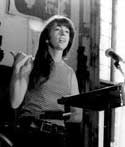
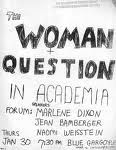
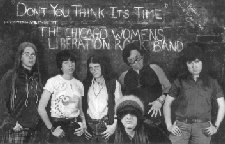
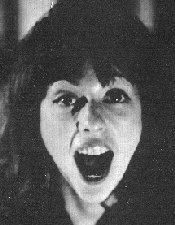

 One of the most brilliant and fascinating of the early radical feminists is Naomi Weisstein, probably best known for her pioneering 1967 essay, Kinder, Kuche, Kirche ( Children, Kitchen, Church ), which started the discipline of the psychology of women, and has been reprinted over 42 times in six different languages.
One of the most brilliant and fascinating of the early radical feminists is Naomi Weisstein, probably best known for her pioneering 1967 essay, Kinder, Kuche, Kirche ( Children, Kitchen, Church ), which started the discipline of the psychology of women, and has been reprinted over 42 times in six different languages.